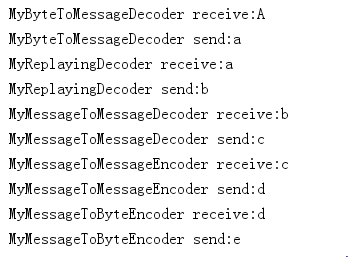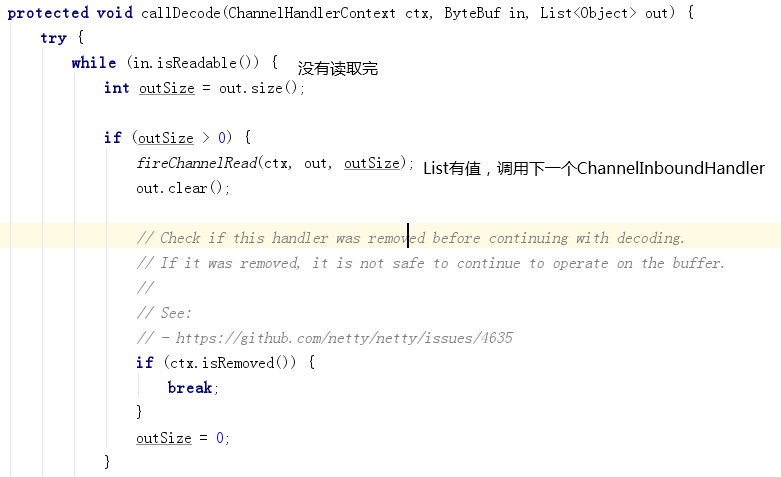网络编程 - Netty(编解码器)
示例
从客户端发送字母A,经过解码器ByteToMessageDecoder、ReplayingDecoder、MessageToMessageDecoder以及编码器MessageToMessageEncoder、MessageToByteEncoder,把A解码为a、b、c,再编码成d、e
服务端
EchoServer
public class EchoServer {
public static void main(String[] args) throws InterruptedException {
// 创建NioEventLoopGroup类型的EventLoopGroup
EventLoopGroup group = new NioEventLoopGroup();
try {
// 创建ServerBootstrap
ServerBootstrap sbs = new ServerBootstrap();
sbs.group(group)
// 设置Channel为NIO的服务端Channel
.channel(NioServerSocketChannel.class)
// 绑定本地端口
.localAddress(new InetSocketAddress(Const.PORT))
// 新连接被接受时,会创建一个Channel
// 再把把echoServerHandler加入到这个Channel的ChannelPipeline中
.childHandler(new ChannelInitializer<SocketChannel>() {
@Override
protected void initChannel(SocketChannel socketChannel) throws Exception {
socketChannel.pipeline().addLast(new MyMessageToByteEncoder());
socketChannel.pipeline().addLast(new MyMessageToMessageEncoder());
socketChannel.pipeline().addLast(new MyByteToMessageDecoder());
socketChannel.pipeline().addLast(new MyReplayingDecoder());
socketChannel.pipeline().addLast(new MyMessageToMessageDecoder());
}
});
// 异步绑定服务器,阻塞到服务器绑定完成
ChannelFuture sync = sbs.bind().sync();
// 获取channel的closeFuture,阻塞到关闭
sync.channel().closeFuture().sync();
} finally {
// 优雅的关掉group并释放所有的资源
group.shutdownGracefully().sync();
}
}
}
MyByteToMessageDecoder
public class MyByteToMessageDecoder extends ByteToMessageDecoder {
/**
* @param ctx
* @param in 传过来的ByteBuf
* @param out 添加解码消息的List
* @throws Exception
*/
@Override
protected void decode(ChannelHandlerContext ctx, ByteBuf in, List<Object> out) throws Exception {
String str = "";
str += (char) in.readByte();
System.out.println("MyByteToMessageDecoder receive:" + str);
str = "a";
ByteBuf byteBuf = Unpooled.buffer();
byteBuf.writeBytes(str.getBytes());
out.add(byteBuf);
System.out.println("MyByteToMessageDecoder send:" + str);
}
}
MyReplayingDecoder
public class MyReplayingDecoder extends ReplayingDecoder<Void> {
@Override
protected void decode(ChannelHandlerContext ctx, ByteBuf in, List<Object> out) throws Exception {
String str = "";
str += (char) in.readByte();
System.out.println("MyReplayingDecoder receive:" + str);
str = "b";
out.add(str);
System.out.println("MyReplayingDecoder send:" + str);
}
}
MyMessageToMessageDecoder
public class MyMessageToMessageDecoder extends MessageToMessageDecoder<String> {
@Override
protected void decode(ChannelHandlerContext ctx, String msg, List out) throws Exception {
System.out.println("MyMessageToMessageDecoder receive:" + msg);
//out.add(msg);
msg = "c";
System.out.println("MyMessageToMessageDecoder send:" + msg);
ctx.write(msg);
}
}
MyMessageToByteEncoder
public class MyMessageToByteEncoder extends MessageToByteEncoder<String> {
@Override
protected void encode(ChannelHandlerContext ctx, String msg, ByteBuf out) throws Exception {
System.out.println("MyMessageToByteEncoder receive:" + msg);
msg = "e";
System.out.println("MyMessageToByteEncoder send:" + msg);
out.writeBytes(msg.getBytes());
ctx.writeAndFlush(out);
}
}
MessageToMessageEncoder
public class MyMessageToMessageEncoder extends MessageToMessageEncoder<String> {
@Override
protected void encode(ChannelHandlerContext ctx, String msg, List out) throws Exception {
System.out.println("MyMessageToMessageEncoder receive:" + msg);
msg = "d";
System.out.println("MyMessageToMessageEncoder send:" + msg);
out.add(msg);
}
}
客户端
Client
public class Client {
public static void main(String[] args) throws InterruptedException {
EventLoopGroup group = new NioEventLoopGroup();
try {
// 创建Bootstrap
Bootstrap bs = new Bootstrap();
bs.group(group)
// 设置Channel为NIO的客户端Channel
.channel(NioSocketChannel.class)
// 设置服务器的地址端口信息
.remoteAddress(new InetSocketAddress(Const.IP, Const.PORT))
.handler(new ChannelInitializer<SocketChannel>() {
@Override
protected void initChannel(SocketChannel ch) throws Exception {
ch.pipeline().addLast(new ClientHandler());
}
});
// 连接远程服务器,阻塞到连接完成
ChannelFuture cf = bs.connect().sync();
// 获取channel的closeFuture,阻塞到关闭
cf.channel().closeFuture().sync();
} finally {
// 优雅的关掉group并释放所有的资源
group.shutdownGracefully().sync();
}
}
}
ClientHandler
public class ClientHandler extends SimpleChannelInboundHandler<ByteBuf> {
/**
* 客户端收到服务器消息后调用
*
* @param channelHandlerContext
* @param byteBuf
* @throws Exception
*/
@Override
protected void channelRead0(ChannelHandlerContext channelHandlerContext, ByteBuf byteBuf) throws Exception {
// 处理收到的消息
System.out.println("客户端收到信息:" + byteBuf.toString(CharsetUtil.UTF_8));
}
/**
* 客户端与服务器连接后调用
*
* @param ctx
* @throws Exception
*/
@Override
public void channelActive(ChannelHandlerContext ctx) throws Exception {
// 当channel是活跃的时候,往服务端发送一条消息
ctx.writeAndFlush(Unpooled.copiedBuffer("A", CharsetUtil.UTF_8));
}
/**
* 客户端处理消息过程中,对异常的处理
*
* @param ctx
* @param cause
* @throws Exception
*/
@Override
public void exceptionCaught(ChannelHandlerContext ctx, Throwable cause) throws Exception {
cause.printStackTrace();
ctx.close();
}
}
运行结果
服务端运行结果

客户端运行结果

解码器
在netty中,解码器包括两种:
- 将字节解码为消息:ByteToMessageDecoder 和 ReplayingDecoder
- 将一种消息解码成另外一种消息:MessageToMessageDecoder
ByteToMessageDecoder
decode(ChannelHandlerContext ctx, ByteBuf in, List<Object> out)
ByteBuf,是调用这个方法时,传入的数据,List是用来存放解码信息的。如果ByteBuf没有读取完,这个List有值,会传入ChannelPipeline的下一个ChannelInboundHandler。

除了decode,这个类还有decodeLast方法,当Channel的状态变为非活动时会被调用。
MessageToMessageDecoder
MessageToMessageDecoder把一种类型的消息转为另外一种,上面例子中,是把String转String,我们简单的做了字符串替换。msg的类型,是需要传入的类型,解析后存入List。
decode(ChannelHandlerContext ctx, String msg, List out)
编码器
编码器也有两种方式:
- 将消息编码为字节:MessageToByteEncoder
- 将消息编码为消息:MessageToMessageEncoder
MessageToByteEncoder
msg,是传入消息的类型及数据,out是会被传到ChannelPipeline的下一个ChannelOutboundHandler。
encode(ChannelHandlerContext ctx, String msg, ByteBuf out)
MessageToMessageEncoder
msg,是传入消息的类型及数据,out是存放编码后的消息,也会被传到ChannelPipeline的下一个ChannelOutboundHandler。
encode(ChannelHandlerContext ctx, String msg, List out)
其他内置的编解码器
- ssl协议:SslHandler
- http:HttpRequestEncoder、HttpResponseEncoder、HttpRequestDecoder、HttpResponseDecoder、FullHttpRequest、FullHttpResponse等
- 空闲的连接和超时:IdleStateHandler、ReadTimeoutHandler、WriteTimeoutHandler
- 半包粘包解决:DelimiterBasedFrameDecoder、LineBasedFrameDecoder、FixedLengthFrameDecoder、LengthFieldBasedFrameDecoder
- 写大型数据:ChunkedWriteHandler
- 序列号反序列:CompatibleObjectDecoder、CompatibleObjectEncoder、ObjectDecoder、ObjectEncoder等
正文到此结束
热门推荐
相关文章
Loading...











![[HBLOG]公众号](https://www.liuhaihua.cn/img/qrcode_gzh.jpg)

